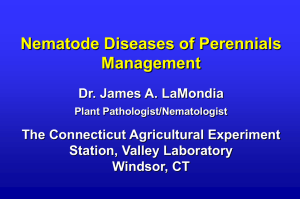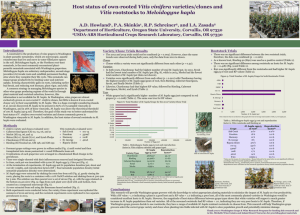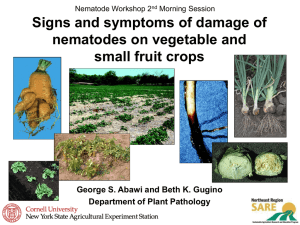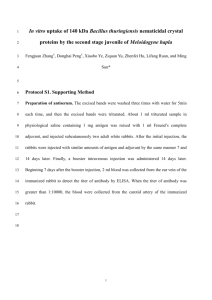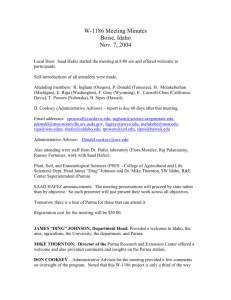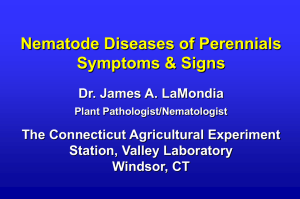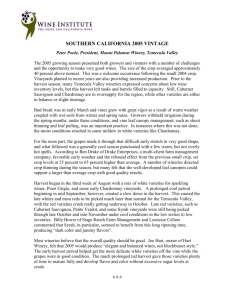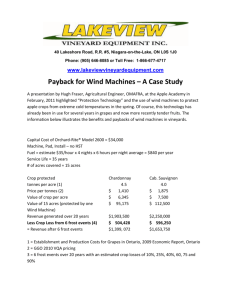Impact of Grapevine (Vitis vinifera) Varieties on Reproduction of the
advertisement
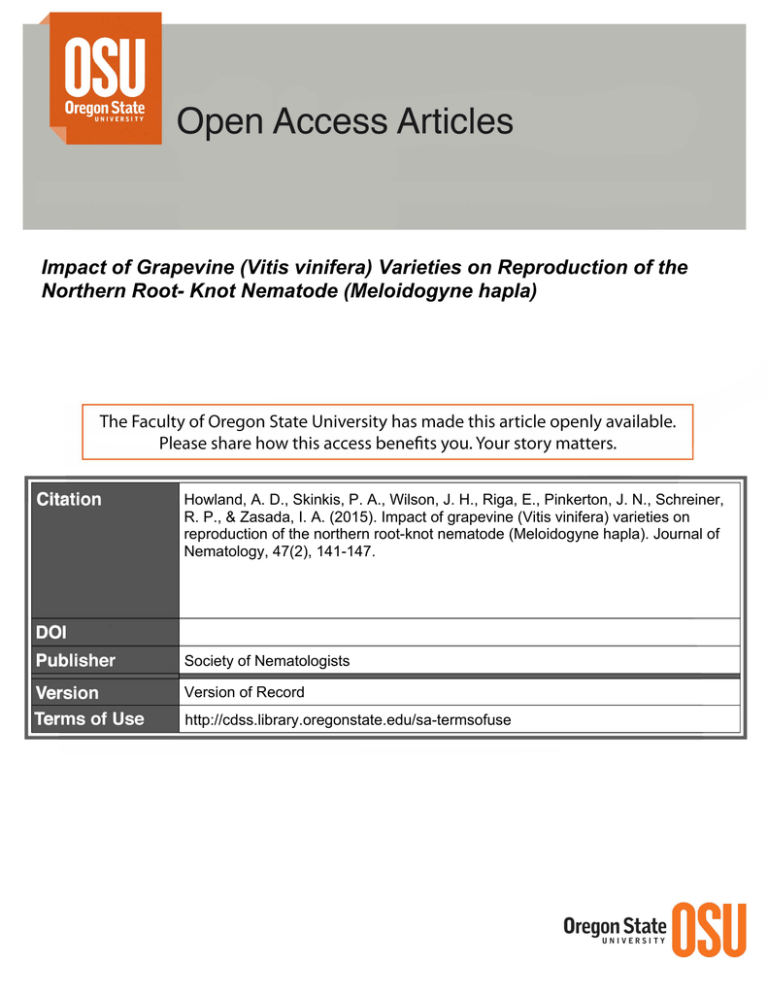
Impact of Grapevine (Vitis vinifera) Varieties on Reproduction of the Northern Root- Knot Nematode (Meloidogyne hapla) Howland, A. D., Skinkis, P. A., Wilson, J. H., Riga, E., Pinkerton, J. N., Schreiner, R. P., & Zasada, I. A. (2015). Impact of grapevine (Vitis vinifera) varieties on reproduction of the northern root-knot nematode (Meloidogyne hapla). Journal of Nematology, 47(2), 141-147. Society of Nematologists Version of Record http://cdss.library.oregonstate.edu/sa-termsofuse Journal of Nematology 47(2):141–147. 2015. Ó The Society of Nematologists 2015. Impact of Grapevine (Vitis vinifera) Varieties on Reproduction of the Northern Root-Knot Nematode (Meloidogyne hapla) AMANDA D. HOWLAND,1 PATRICIA A. SKINKIS,1 JOHN H. WILSON,2 EKATERINI RIGA,2 JOHN N. PINKERTON,3 R. PAUL SCHREINER,3 AND INGA A. ZASADA3 Abstract: One of the most commonly encountered plant-parasitic nematodes in eastern Washington Vitis vinifera vineyards is Meloidogyne hapla; however, limited research exists on the impact of this nematode on V. vinifera. The objectives of this research were to determine the impact of M. hapla on Chardonnay and Cabernet Sauvignon vine establishment and to determine the host status of V. vinifera varieties/clones predominantly grown in Washington to M. hapla. In a microplot experiment, Chardonnay and Cabernet Sauvignon vines were planted into soil inoculated with different densities of M. hapla; population dynamics of M. hapla and vine performance were monitored over 3 yr. In greenhouse experiments, several clones representing five V. vinifera varieties, Chardonnay, Riesling, Cabernet Sauvignon, Merlot, and Syrah, were evaluated as hosts for M. hapla. In both microplot and greenhouse experiments, white varieties were significantly better hosts than red varieties. In the greenhouse experiments, Chardonnay and Riesling had 40% higher reproduction factor values than Syrah and Merlot, however, all varieties/clones screened were good hosts for M. hapla (reproduction factors . 3). In the microplot experiment, M. hapla eggs/g root were 4.5 times greater in Chardonnay compared to Cabernet Sauvignon 3 yr after planting but there was no evident impact of M. hapla on vine establishment. Key words: host-parasite interaction, host status, M. hapla, microplots, own-rooted, Washington. Washington is the second largest wine-producing state in the United States with an economic value of $233 million (USDA, 2014). More than 30 different varieties of wine grapes are cultivated on the 18,211 ha of vineyards in Washington (USDA, 2014) mostly located on the eastern side of the state. Predominantly white grape varieties are grown, with Chardonnay and Riesling leading production. Leading red varieties are Cabernet Sauvignon, Merlot, and Syrah. Due to a low mean annual rainfall of 20 cm and a photoperiod of approximately 16 hr during the summer, vineyards in eastern Washington are semi-arid and drip irrigated to maintain productivity. Washington vineyards are primarily planted with own-rooted grapevines (V. vinifera) as opposed to grapevines grafted onto rootstocks due to cold tolerance and frost concerns (Keller et al., 2012). Plant-parasitic nematodes, a global pest estimated to cause $100 billion economic loss to agriculture worldwide (Sasser and Freckman, 1987), are commonly found in Washington vineyards. Surveys of vineyards were conducted in eastern Washington by Zasada et al. (2012) who found Meloidogyne hapla, the northern rootknot nematode, to be the most abundant nematode present; it was found in 60% of the surveyed vineyards. Meloidogyne spp., or root-knot nematodes, are a significant production and economic constraint to grapevines worldwide. A sedentary endoparasite, these nematodes Received for publication January 12, 2015. 1 Department of Horticulture, Oregon State University, 4017 Agriculture and Life Sciences Building, Corvallis, OR 97330. 2 Washington State University Irrigated Agriculture Research & Extension Center, 24106 N. Bunn Rd., Prosser, WA 99350. 3 U.S. Department of Agriculture-Agricultural Research Service, Horticultural Crops Research Laboratory, 3420 NW Orchard Avenue, Corvallis, OR 97330. This research was funded by the Northwest Center for Small Fruit Research and the Washington Grape & Wine Research Program. The authors thank Marj Lauer, Duncan Kroese, Amy Peetz, and Mariella Ballato for technical assistance. Mention of trade names or commercial products in this article is solely for the purpose of providing specific information and does not imply recommendation or endorsement by the U.S. Department of Agriculture. E-mail: inga.Zasada@ars.usda.gov This paper was edited by Andrea M. Skantar. remain stationary inside the roots of a host plant for most of their lives. Adult females lay their eggs outside the roots in a gelatinous matrix; a single egg mass can contain up to 1,000 eggs (de Guiran and Ritter, 1979). Under optimal conditions, the lifecycle of this nematode can take 5 wk to complete, producing several generations per season (de Guiran and Ritter, 1979; Nicol et al., 1999; Esmenjaud and Bouquet, 2009). In the United States, Meloidogyne spp. have been reported to reduce grapevine yields by up to 20% (Anwar and McKenry, 2000). Seven species of Meloidogyne are found on grapevines, but only four species, M. incognita, M. hapla, M. javanica, and M. arenaria, are considered to be damaging (Esnard and Zuckerman, 1998; Esmenjaud and Bouquet, 2009); in Washington, only M. hapla has been found (Zasada et al., 2012). Although M. hapla is abundant and widespread in Washington’s semi-arid vineyards, very little is known about the pathogenicity of M. hapla to commonly planted V. vinifera varieties used in this region and the host status of these varieties to the nematode. Although the effect Meloidogyne spp. have on grapevines is well researched in other grape-producing regions, such as California (Lider, 1960; Ferris and McKenry, 1975; Anwar and Gundy, 1989) and Australia (Stirling and Cirami, 1984; Nicol et al., 1999), these locations have different climates and species of Meloidogyne compared to Washington. Therefore, the effect M. hapla has on grapevines in Washington remains unknown. This is an oversight considering 27% of vineyards in Washington had M. hapla population densities above 100 M. hapla/ 250 g soil (Zasada et al., 2012), the theoretical threshold for this nematode (Santo, unpublished data). The objectives of this research were to (i) evaluate the impact of M. hapla, as well as population dynamics of this nematode, on own-rooted Chardonnay and Cabernet Sauvignon, and (ii) determine the host status of V. vinifera varieties and clones commonly grown in Washington to M. hapla. 141 142 Journal of Nematology, Volume 47, No. 2, June 2015 MATERIALS AND METHODS Microplot experiment: A 4 3 2 factorial experiment with four different population densities of M. hapla (0, 50, 150, and 300 eggs/250 g soil) and with two different own-rooted V. vinifera varieties (Chardonnay and Cabernet Sauvignon) was established in 114 liters potin-pot (Parkerson, 1990) microplots (Nursery Supplies Inc., McMinnville, OR). Each treatment combination was replicated seven times in a randomized complete block design for 56 experimental units (microplots). The experiment was conducted at the Washington State University, Irrigated Agriculture Research & Extension Center, Prosser, WA. The experiment was conducted in a field with a Warden silt loam soil. The area was deep ripped to 45 cm after which Telone II (1,3-dichloropropene) was shanked into the soil to a depth of 30 cm at a rate of 185 liters/ha in October 2006. The microplots were arranged on a 1.5 3 3.0 m spacing and placed into 60 cm deep 3 60 cm in diameter augered holes. Prior to the placement of microplots, a 5-cm-deep layer of gravel was placed in the bottom of each hole. The pots were then filled with soil and additionally fumigated with metam sodium at a rate of 589 liters/ha as a drench in 2 liters of water. The following spring, May 2007, prior to planting, a population of M. hapla originally isolated from an alfalfa (Medicago sativa L.) field in Washington, and maintained on pepper (Piper nigrum L. cv. California Wonder) in a greenhouse, was added to appropriate microplots depending upon the inoculation density required. M. hapla eggs were extracted from pepper roots by shaking roots in 0.05% NaOCl solution for 3 min (Hussey and Barker, 1973). The egg solution was then poured over nested 250- and 25-mm sieves with eggs being retained on the 25-mm sieve. Eggs were collected in water and adjusted to achieve desired inoculation densities. At inoculation, the eggs for each pot were first added to 1 liter of moistened pasteurized soil and gently mixed. At each microplot, including the noninoculated microplots, two-thirds of the soil was removed from the microplot and one-third of the inoculum was added to the soil surface and mixed into the soil and then covered with more soil. This was repeated two more times to completely fill the microplots. Care was taken to avoid contamination of the surrounding soil and equipment. Rooted cuttings of Chardonnay clone 02 or Cabernet Sauvignon clone 04 (Inland Desert Nursery, Benton City, WA) were planted into microplots immediately after inoculation. The single shoot was staked and grown without manipulation throughout 2007. Due to poor initial vine growth in 2007 resulting from transplant shock, vines were two budded during the dormant period in 2008 and a single shoot was again retained on all vines for the 2008 growing season. In 2009 and 2010, two buds were retained per vine and both main shoots were trained vertically on a single stake up to a height of 2 m. Lateral shoots that developed in 2009 and 2010 were retained, but were not further manipulated producing a bush-type canopy. All fruit clusters produced on vines in 2009 and 2010 were also retained. Microplots were kept well-watered during the growing season by applying irrigation water two to three times per wk by hand as dictated by weather conditions. All microplots were watered to field capacity. Microplots were fertilized in the spring of each year ~2 wk after budburst. Each microplot received 50 g of a complete fertilizer (20-10-20 with micronutrients; Peters Professional, Scott Chemical Co., St Louis, MO) broadcast over the soil surface. Fungicides to control powdery mildew and bunch rot were applied as per normal practices in the region. M. hapla population dynamics in soil were monitored in the spring (April or May) and fall (October) of each year, beginning in October 2007. Nematodes were extracted from two soil cores (1.5-cm diameter 3 45-cm deep) collected from each microplot; core holes were filled with fumigated soil after each sampling. Nematodes were extracted from the entire soil sample (after obtaining total wet weight) by elutriation (Byrd et al., 1976) and centrifugation methods (Jenkins, 1964) and enumerated under a stereoscope. M. hapla egg population densities in roots were also determined in spring and fall of 2009 and fall of 2010. In 2009, before processing the soil sample for vermiform M. hapla, roots contained in the cores were handpicked from soil, rinsed, and placed in a 50-ml polyethylene tube with a 0.25% NaOCl solution and shaken at 300 rpm for 3 min on a Lab Companion SK-600 Benchtop Shaker (Jeio Tech, Seoul, Korea) to free M. hapla eggs from the gelatinous matrix attached to the root. After the roots were shaken, the solution was poured over nested 90- and 25-mm sieves. The roots were removed from the 90-mm sieve, placed in an oven, dried for 5 d at 1058C, and weighed to obtain root dry weight. The eggs retained on the 25-mm sieve were back-washed into a 50-ml polyethylene tube. In fall 2010, after destructively harvesting the vines (see below), a subsample of fine roots were collected and processed similarly to that described above. Number of M. hapla eggs in a sample were enumerated under an inverted microscope. At the termination of the experiment in October 2010, the aboveground portion of the vine was removed and partitioned into new wood (canes) and old wood (trunks and cordons). Tissues were air dried, then placed in a 1058C oven for 24 hr and weighed to obtain dry weights. Pots were then removed from the ground with a frontend loader, the contents of the pot placed on a screen supported by saw horses, and the roots were washed free of soil. A subsample of fine roots was removed from the root system to quantify M. hapla eggs in roots (see above) and the remainder of the root system was air dried, placed in a 1058C oven for 24 h, and then weighed. Data were analyzed for effects of M. hapla inoculation density, variety, and inoculation density 3 variety interactions using a repeated measure mixed linear model Impact of Grapevine Varieties on M. hapla: Howland et al. 143 analysis of variance (ANOVA) with inoculation density and variety as fixed factors and block as a random factor. No M. hapla J2 or eggs were found in the noninoculated controls (0 eggs/g soil) and these data were excluded from the analysis. Soil and root data for M. hapla were initially transformed by log10 (x + 1) to correct for heteroscedasticity. Treatment means in all analyses were separated using Tukey’s Honestly Significant Differences (HSD) test (P # 0.05). All analyses were performed using JMP 9.1 (SAS Institute Inc., Cary, NC). Variety/clone greenhouse experiment: The varieties and clones evaluated included: Merlot clone 03, Merlot 06, Merlot 15, Cabernet Sauvignon 02, Cabernet Sauvignon 04, Cabernet Sauvignon 06, Cabernet Sauvignon 21, Syrah Shiraz 07, Syrah 07, Syrah Phelps, Chardonnay 06, Chardonnay 15, White Riesling Neustad 90, White Riesling GM 198, and White Riesling GM 239. Dormant grape cuttings were obtained late winter of 2012 and 2013 (Ste. Michelle Wine Estates, Prosser, WA). Cuttings of each clone were categorized into similar sizes to ensure uniformity. Fifteen cuttings of each clone were cut into three node segments with the bottom node cut diagonally and rooted in perlite and vermiculite potting media (Santo and Hackney, 1980). The cuttings were then placed on a mist bench with a heating pad for 2 mon. In April of each year, the grapes were removed from the mist bench and placed in a greenhouse under shade cloth to harden off. A week later, eight established grape cuttings of each clone were transplanted into 3.7liter pots containing steam pasteurized 1:1 sand:Willamette loam soil. Pots were arranged in a randomized block design with eight blocks in the greenhouse. The vines were thinned to a single shoot and inflorescences removed to promote root growth. The grapevines were fertigated biweekly with 20-20-20 NPK (20N-8.8P-16.6K; Scotts, Marysville, OH) throughout the duration of the experiment. The grapevines were grown in a greenhouse with a 16 hr/d photoperiod; temperatures were set to 258C during the day and 208C at night. M. hapla originally collected from a V. vinifera vineyard in Veneta, OR, and reared on tomato (Lycopersicon esculentum Mill. cv. Rutgers), was used as inoculum. Inoculum was obtained by destructively harvesting tomato plants and collecting eggs from washed roots as described above. In early June of each year, the grapevines were inoculated with a density of three M. hapla eggs/g of soil which was equivalent to 9,000 eggs/3.7 liter pot. The inoculum was applied by pipetting 2 ml of inoculum into six holes approximately 4-cm deep around the base of the vine. Plants were destructively harvested in the fall of each year. For each vine, the shoot was removed, placed in a paper bag, dried at 1058C for 5 d, and weighed. Roots were shaken free of soil and a 50 g subsample of soil from each pot was collected to extract M. hapla using the Baermann funnel method (Ingham, 1994). Roots were then gently rinsed free of soil. M. hapla eggs were extracted from the entire root system as described above. The number of eggs in 1 ml of the 50 ml egg solution was determined using an inverted microscope. The remaining roots were oven dried as per shoots. M. hapla data are presented as eggs/g root and total/ pot (eggs + J2). In addition, reproduction factor values, RF= final nematode population/initial nematode population (Oostenbrink, 1966) were calculated. Before analysis, nematode and plant data were log10 (x + 1) transformed to fulfill normality and equal variance assumptions of the model (R Studio v0.98, Boston, MA). After transformation, data were analyzed using a oneway ANOVA with first clone and then variety (excluding Shiraz since only one clone was included in the experiment) as main effects and block as a random effect. Data from the 2012 and 2013 trials were analyzed separately because the trials were significantly different from each other (P # 0.001). Mean separations were performed using Tukey’s HSD test (P # 0.05). RESULTS Microplot experiment: In the analysis of M. hapla J2/250 g soil, inoculation density and the variety 3 inoculation density interaction were not significant (P . 0.01), therefore, M. hapla J2 population densities across inoculation densities were averaged for each variety within a sampling date (Fig. 1). Population densities of M. hapla J2/250 g soil were greater in Chardonnay than in Cabernet Sauvignon starting in fall of 2008, 1.5 years after planting (P # 0.001) (Fig. 1). By the fall of 2010, M. hapla J2 population densities were 29 times higher in Chardonnay than in Cabernet Sauvignon. In the analysis of M. hapla eggs/g root, there were significant difference over time for both variety and inoculation density (P # 0.001), but not for the interaction (P . 0.1) (Table 1). FIG. 1. Effect of Vitis vinifera varieties Chardonnay and Cabernet Sauvignon, on population densities of Meloidogyne hapla second-stage juveniles (J2) in a microplot experiment over time. Data was log10(x + 1) transformed prior to analysis; nontransformed means ± standard error are presented (n = 21). Letters above symbols indicate significant differences according to Tukey’s honestly significant difference test (P # 0.05). 144 Journal of Nematology, Volume 47, No. 2, June 2015 TABLE 1. Effects of own-rooted Vitis vinifera varieties Chardonnay and Cabernet Sauvignon and inoculation densities of Meloidogyne hapla on subsequent M. hapla egg population densities in a microplot experiment. Spring 2009 Effect Variety Initial densityb Treatment Fall 2009 Fall 2010 M. hapla eggs/g dry root Chardonnay Cabernet Sauvignon Zeroc Low Medium High 23 ba 1a 14 b 4a 408 c 90 b 0 19 ab 9a 23 ab 0 7a 10 ab 18 ab 0 152 bc 324 cd 557 d a Values are the means of seven observations. Data were log10(x + 1) transformed prior to analysis; nontransformed means are presented. Means followed by the same letter within an effect are not significantly different according to Tukey’s honestly significant difference test (P # 0.05). b Zero = no M. hapla; Low = 50 M. hapla eggs/250 g soil; Medium = 150 M. hapla eggs/250 g soil; and High = 300 M. hapla eggs/250 g soil. c Data from the noninoculated control (zero) were not included in the analyses. Across all sampling dates, population densities of M. hapla eggs were always higher in Chardonnay than in Cabernet Sauvignon. At the final sampling date (fall of 2010), there were 4.5 times as many M. hapla eggs in roots of Chardonnay than in roots of Cabernet Sauvignon. When inoculation density was considered, only the densities at the final sampling date (fall 2010) differed from the densities at the other sampling dates (P # 0.001). At that time, there were 3.7 more M. hapla eggs in roots of vines inoculated with high (300 eggs/250 g soil) vs. low (50 eggs/250 g soil) initial densities. There were no differences in pruning weights (2008 and 2009) or any vine tissues from the final destructive harvest in 2010 (new wood, old wood, and roots) among the treatments (P $ 0.05) (data not shown). Variety/clone greenhouse experiment: Differences were observed in M. hapla J2, egg, and total population densities among the clones in both years. In 2012, both of the Chardonnay clones had the highest densities of M. hapla eggs/g of root, followed by all three Riesling clones (Table 2); Merlot 06 and 03 had the fewest M. hapla eggs/g of root. The number of M. hapla J2/250 g of soil between the grape clones did not differ (data not shown). When total M. hapla population densities (eggs + J2) was considered, both Chardonnay clones had the greatest densities of M. hapla, followed by the Riesling clones, while the Syrah/Shiraz and Merlot clones had the lowest total number of M. hapla (Table 2). Similar trends were observed in 2013; all three Merlot clones had the lowest M. hapla eggs/g of root. Chardonnay 06 followed by Riesling 239 and Chardonnay 15 had the greatest densities of M. hapla eggs/g of root (Table 2). M. hapla J2/250 g in soil differed among clones (P = 0.036), with the Syrah and Merlot clones having the lowest M. hapla J2/250 g of soil (data not shown). Chardonnay 06 followed by Riesling 239 and Chardonnay 15 had the greatest densities of total M. hapla; all three Merlot clones had the lowest total number of M. hapla (Table 2). In both years, Chardonnay 06 had the greatest density of M. hapla eggs/g of root and total number of M. hapla/pot. The grapes with the highest RF values in 2012 and 2013 were both the Chardonnay clones and the three Riesling clones. Syrah Phelps had the lowest RF value in 2012 while the Merlot clones had the lowest RF values in 2013 (Table 2). In both years, shoot dry weight ranged from 7.47 to 15.79 g and root dry weight ranged from 7.02 to 18.28 g (data not shown). For comparison across varieties, clones within a variety were combined for analysis. In both years, Chardonnay had the greatest density of M. hapla eggs/g of root and RF values (Table 3). Although Chardonnay had a similar number of M. hapla eggs/g of root to that of Riesling, RF values in both years were significantly TABLE 2. Meloidogyne hapla eggs/g root and total M. hapla (eggs + J2) recovered from inoculated vines, and reproduction factor (RF) values of M. hapla in a greenhouse trial evaluating the host status of Vitis vinifera varieties and clones in 2 yr. M. hapla eggs/g of root RFb M. haplas/g of root 2012 Variety/Clone Cabernet Sauvignon 02 Cabernet Sauvignon 04 Cabernet Sauvignon 06 Cabernet Sauvignon 21 Chardonnay 06 Chardonnay 15 Merlot 03 Merlot 06 Merlot 15 Syrah 07 Syrah Phelps Shiraz 07 Riesling 90 Riesling 198 Riesling 239 Total M. hapla 10,540 ea 11,530 e 14,410 cde 10,890 e 50,620 a 32,830 ab 5,301 e 5,044 e 8,040 e 12,550 de 6,936 e 12,750 de 31,290 bc 30,670 bcd 22,160 bcde 187,000 bcd 214,000 bcd 190,600 bcd 179,100 cd 528,100 a 411,800 ab 69,960 d 102,700 d 146,500 cd 66,300 d 51,030 d 123,200 d 351,100 abc 278,900 bcd 238,000 bcd Total M. hapla RF 2013 20.1 bcd 22.5 bcd 20.2 bcd 19.0 cd 57.0 a 44.5 ab 7.4 d 10.4 d 14.3 cd 7.0 d 5.3 d 13.0 d 38.1 abc 30.1 bcd 25.0 bcd 8,356 d 10,360 cd 12,300 bcd 11,060 bcd 34,820 a 23,530 abc 4,103 d 5,281 d 5,417 d 17,950 bcd 7,666 d 14,150 bcd 16,650 bcd 13,610 bcd 25,620 ab 79,760 de 93,490 cde 92,310 cde 128,600 cde 304,600 a 199,400 abc 35,910 e 59,040 de 49,480 de 107,000 cde 74,320 de 104,400 cde 163,600 bcd 135,400 cde 267,600 ab 8.4 de 9.9 cde 9.9 cde 10.4 cde 32.8 a 21.3 abc 3.9 e 6.3 de 4.7 de 11.8 cde 8.1 de 10.9 cde 16.9 bcd 14.7 cde 27.7 ab a Values are the means of eight observations. Nematode data were log10(x + 1) transformed prior to analysis; nontransformed means are presented. Means followed by the same letter are not significantly different according to Tukey’s honestly significant difference test (P # 0.05). b RF values calculated as final nematode population density/initial nematode population density. Impact of Grapevine Varieties on M. hapla: Howland et al. 145 TABLE 3. Meloidogyne hapla eggs/g root and reproduction factor (RF) values on Vitis vinifera varieties in greenhouse experiments. M. hapla eggs/g root Variety Chardonnay Riesling Cabernet Sauvignon Syrah Merlot RFb 2012 a 45,786 a 33,759 a 19,885 b 8,507 b 13,166 b M. hapla eggs/g root RFb 2013 45.1 a 27.6 b 18.2 bc 7.9 c 9.5 c 26,990 a 17,180 ab 9,776 bc 11,720 bc 4,645 c 27.1 a 19.8 b 9.6 bc 10.3 c 4.9 c a Values are the means of eight observations. Nematode data were log10(x + 1) transformed prior to analysis; nontransformed means are presented. Means followed by the same letter are not significantly different according to Tukey’s honestly significant difference test (P # 0.05). b RF values calculated as final nematode population density/initial nematode population density. higher for Chardonnay than Riesling (P # 0.001). Chardonnay and Riesling always had greater densities of M. hapla eggs/g root and RF values than the other varieties. Syrah had the fewest M. hapla eggs/g of root and RF value in 2012 while Merlot had the fewest M. hapla eggs/g of root and RF value in 2013. In 2012, the number of M. hapla eggs/g of root and RF value in Chardonnay were 6 to 7 times greater than the corresponding measurements in Syrah. Likewise, in 2013, Chardonnay had six times more M. hapla eggs/g of root and RF value than Merlot. DISCUSSION To our knowledge, this is the first report of differences in host status of V. vinifera grape varieties to M. hapla. This difference was first observed in the microplot experiment when population densities of M. hapla J2 were 6.5 times greater in Chardonnay than in Cabernet Sauvignon 1.5 years after inoculation and planting. This trend continued throughout the life of the microplot experiment with the magnitude of this difference becoming greater over the 3.5-year period. This result was further supported in greenhouse experiments evaluating a wider range of V. vinifera varieties and clones as hosts for M. hapla. While all of the V. vinifera varieties evaluated in the greenhouse experiments are considered good (10 . RF . 1) to excellent (RF . 10) hosts (Ferris et al., 1993) for M. hapla, the magnitude of increase in population size of M. hapla on the two white varieties (Chardonnay and Riesling) was much greater than two of the red varieties (Merlot, and Syrah), with Cabernet Sauvignon being intermediate between them. Differences in host status of V. vinifera varieties for Meloidogyne arenaria have been previously documented (Ferris et al., 1982). The V. vinifera varieties Carignane, Barbera, French Colombard, Ruby Cabernet, Cabernet Sauvignon, and Zinfandel were all susceptible to M. arenaria while Tokay, Thompson Seedless, and Perlette were moderately resistant. Unlike our results with M. hapla, the trend for white varieties to be consistently better hosts than red varieties was not observed for M. arenaria. Although there were differences in the host status of grape varieties to M. hapla, clones within a variety did not differ. V. vinifera clones originate from slight genetic mutations during asexual propagation (Hartmann et al., 1990), and therefore, clones of the same variety are very similar in their genetic makeup. Conversely, the genetic makeup of different V. vinifera varieties is more diverse, and this may explain why the V. vinifera varieties evaluated in these trials varied in host status to M. hapla. The finding that white V. vinifera varieties are better hosts for M. hapla may be due to differences in rooting behavior, production of root or rhizosphere metabolites, or other factors. In our greenhouse experiment, the root systems of the white varieties appeared to have a much greater abundance of fine feeder roots compared to the red varieties, although this was not directly quantified. Fine roots are the preferred entry site for juveniles, which invade right behind the root tip (de Guiran and Ritter, 1979). Therefore, with more fine roots, there are more potential sites for nematode invasion which could lead to a higher rate of infection. Also, McKenry and Anwar (2006) reported that grapes with widespread root systems have root tips far apart from each other, reducing penetration and success of Meloidogyne spp. This could help explain why red varieties with fewer fine roots would result in a lower M. hapla invasion than white varieties, which have an abundance of fine roots. Another potential explanation for the difference in host status of white and red V. vinifera varieties to M. hapla may be related to the quantity and/or quality of root exudates that influence initial contact with nematode juveniles. The rhizosphere, located about 0 to 2 mm from the root surface, plays a significant role in root exudate production and secretion and is known to greatly influence soil ecology (Bertin et al., 2003). A major source of exudates in the rhizosphere is right behind the root tip; the production of root exudates in this region may allow exudates to attract and/or repel Meloidogyne spp. due to their preference to this region of root (Huang, 1985; Anwar and McKenry, 2000). Different plant species and different varieties within a species secrete different exudates (Rovira, 1969). This could be true for V. vinifera as well; red varieties may secrete root exudates that are less attractive or detrimental to M. hapla, while white varieties may secrete root exudates that are more attractive to M. hapla. This idea is supported by Huang (1985) who reported that roots of susceptible and resistant plants, even within a genus, can vary in their attractiveness to Meloidogyne spp., although the exudates responsible for attraction or repulsion are unknown. In the microplot experiment, M. hapla did not impact vine establishment or productivity based on seasonal prune weights or whole plant biomass at the final 146 Journal of Nematology, Volume 47, No. 2, June 2015 harvest, despite the nematode reaching high densities in soil. The population densities of M. hapla found in Chardonnay were well above those reported for Meloidogyne spp. to cause damage to V. vinifera grapevines (Nicol et al., 1999). The microplots were a very conducive environment for M. hapla population increase in Chardonnay, similar to what was observed in microplot studies with Mesocriconema xenoplax where greater fine root abundance provided easier access to fine roots and resulted in higher nematode abundance than in field soils (Schreiner et al., 2012b). However, the artificial environment of microplots may have also negated any impact of M. hapla on vine growth. For example, the vines in this study received more water than would normally be applied to vineyards in eastern Washington, as wine grapes in this region are grown under regulated deficit irrigation to reduce vegetative growth and encourage fruit development (Schreiner et al., 2007). The effects of nematode parasitism may not become apparent until vines are under additional stressors, as indicated by the finding that high-vigor vines are better able to tolerate nematode parasitism (Ferris and McKenry, 1975). Mesocriconema xenoplax had a greater impact on vine productivity when additional stressors, low light or partial defoliation, were introduced (Schreiner et al., 2012a). This impact was attributed to nematode parasitism reducing carbohydrate reserves in the roots and wood needed to support growth in future years. The goal of adding different densities of M. hapla to the microplots was to ascertain if a particular threshold population of M. hapla at planting time could be identified that causes damage to newly planted ownrooted V. vinifera. However, we did not observe a difference in vine growth as a function of inoculation density or even a consistent difference in M. hapla population densities in soil or roots. Defining the impact between initial population densities of plantparasitic nematodes on vine growth and yield has been elusive for many researchers (Nicol et al., 1999). Understanding the relationship of plant-parasitic nematode densities and response of perennials is complex due to numerous factors including, but not limited to, reintroduction of nematodes, presence of nondectectable densities, survival in soil, and decline in nematode populations after damage to the perennial host (Barker and Olthof, 1976). Population densities of other Meloidogyne spp. reported to cause damage to V. vinifera are 150 eggs/g root (Sauer, 1977) and 50 J2/ 250 g soil (McKenry, 1992). Population densities in excess of these proposed thresholds were consistently observed for M. hapla in this study. It is difficult to relate thresholds proposed in other regions to the eastern Washington wine grape growing region because of differences in climate and Meloidogyne spp. This research expands the knowledge of the host status of several V. vinifera varieties to M. hapla. Our results indicate that own-rooted white varieties (Chardonnay and Riesling) are significantly better hosts to M. hapla than the red varieties (Syrah, and Merlot). While the red varieties will still support M. hapla reproduction, the population build up in the soil might be slower compared to white varieties, potentially allowing better grapevine establishment and tolerance to M. hapla parasitism. Additional work is still required to understand the effects of M. hapla on vine establishment and productivity in eastern Washington to help guide management decisions. LITERATURE CITED Anwar, S. A., and McKenry, M. V. 2000. Penetration, development, and reproduction of Meloidogyne arenaria on two new resistant Vitis spp. Nematropica 30:9–17. Anwar, S. A., and Van Gundy, S. D. 1989. Influence of four nematodes on root and shoot growth parameters in grape. Journal of Nematology 21:276–283. Barker, K. R., and Olthof, T. H. A. 1976. Relationships between nematode population densities and crop responses. Annual Review of Phytopathology 14:327–353. Bertin, C., Yang, X., and Weston, L. A. 2003. The role of root exudates and allelochemicals in the rhizosphere. Plant and Soil 256:67–83. Byrd, D. W., Jr., Barker, K. R., Ferris, H., Nusbaum, C. J., Griffen, W. E., Small, H. R., and Stone, C. A. 1976. Two semi-automatic elutriators for extracting nematodes and certain fungi from soil. Journal of Nematology 8:206–212. Esmenjaud, D., and Bouquet, A. 2009. Selection and application of resistant germplasm for grapevine nematodes management. Pp. 195– 241 in A. Ciancia and K. G. Mujerji, eds. Integrated management of fruit crops and forest nematodes, vol. 4. Dordrecht, the Netherlands: Springer Science+Business Media. Esnard, J., and Zuckerman, B. M. 1998. Small fruits. Pp. 685–725 in K. R. Barker, G. A. Pederson, and G. L. Windham, eds. Plant and nematode interactions. Madison, WI: ASA, CSSA, SSA Publishers. Ferris, H., Carlson, H. L., Viglierchio, D. R., Westerdahl, B. B., Wu, F. W., Anderson, C. E., Juurman, A., and Kirby, D. W. 1993. Host status of selected crops to Meloidogyne chitwoodi. Journal of Nematology 25:849–183. Ferris, H., and McKenry, M. V. 1975. Relationship of grapevine yield and growth to nematode densities. Journal of Nematology 7:295–304. Ferris, H., Schneider, S. M., and Stuth, M. C. 1982. Probability of penetration and infection by root-knot nematode, Meloidogyne arenaria, in grape cultivars. American Journal of Enology and Viticulture 33:31–35. Ferris, H., Zheng, L., and Walker, M. A. 2012. Resistance of grape rootstocks to plant-parasitic nematodes. Journal of Nematology 44:377–386. de Guiran, G., and Ritter, M. 1979. Life cycle of Meloidogyne species and factors influencing their development. Pp. 173–191 in F. Lamberti and C. E. Taylor, eds. Root-knot nematodes (Meloidogyne species): Systematics, biology, and control. New York, NY: Academic Press. Hartmann, H. T., Kester, D. E., and Davies, F. T., Jr. 1990. Plant propagation principles and practice, 5th ed. Englewood Cliffs, NJ: Prentice Hall. Haynes, R. L., and Jones, C. M. 1976. Effects of the Bi locus in cucumber on reproduction, attraction, and response of the plant to infection by the southern root-knot nematode. Journal of the American Society for Horticultural Science 101:422–424. Huang, J. S. 1985. Mechanisms of resistance to root-knot nematodes. Pp. 165–174 in J. N. Sassar and C. C. Carter, eds. An advanced Impact of Grapevine Varieties on M. hapla: Howland et al. 147 treatise on Meloidogyne, vol. 1. Biology and control. Raleigh, NC: North Carolina State University. Hussey, R. S., and Barker, K. R. 1973. A comparison of methods of collecting inocula of Meloidogyne spp., including a new technique. Plant Disease Reporter 57:1025–1028. Ingham, R. E. 1994. Nematodes. Pp. 459–490 in R. W. Weaver, J. S. Angle, and P. S. Bottomley, eds. Methods of soil analysis: Part 2- microbiological and biochemical properties. Madison, WI: Soil Science Society of America, Inc. Jenkins, W. R. 1964. A rapid centrifugal-flotation technique for separating nematodes from soil. Plant Disease Reporter 48:692. Keller, M., Mills, L. J., and Harbertson, J. F. 2012. Rootstock effects on deficit-irrigated winegrapes in a dry climate: Vigor, yield formation, and fruit ripening. American Journal of Enology and Viticulture 63:29–39. Lider, L. A. 1960. Vineyard trials in California with nematoderesistance grape rootstocks. Higardia 30:123–151. McKenry, M. V. 1992. Nematodes. Pp. 281–285 in D. L. Flaherty, L. P. Christensen, W. T. Lanini, J. J. Marois, P. A. Phillips, and L. T. Wilson, eds. Grape pest management, 2nd ed. Riverside, CA: Division of Agriculture and Natural Resources, University of California. McKenry, M. V., and Anwar, S. A. 2006. Nematode and grape rootstock interactions including an improved understanding of tolerance. Journal of Nematology 38:312–318. Nicol, J. M., Stirling, G. R., Rose, B. J., May, P., and Van Hesswijck, R. 1999. Impact of nematodes on grapevine growth and productivity: Current knowledge and future directions, with special reference to Australian viticulture. Australian Journal of Grape and Wine Research 5:109–127. Oostenbrink, M. 1966. Major characteristics of the relation between nematodes and plants. Mededelingen Landbouwhogeschool Wageningen 66:1–46. Parkerson, C. H. 1990. P&P: A new field-type nursery operation. Proceedings of the International Plant Propagation Society 40: 417–419. Rovira, A. 1969. Plant root exudates. Botanical Review 35:35–57. Santo, G. S., and Hackney, R. W. 1980. Reproduction and pathogenicity of three isolates of Meloidogyne hapla Race A on Concord grapes. Journal of Nematology 12:86–87. Sasser, J. N., and Freckman, D. W. 1987. A world perspective on nematology: The role of the society. Pp. 7–14 in J. A. Veech and D. W. Dickson, eds. Vistas on nematology: A commemoration of the twentyfifth anniversary of the Society of Nematologists. Hyattsville, MD: Society Nematologists. Sauer, M. R. 1977. Nematode resistant grape rootstocks. Australian Dried Fruit News 5:10–14. Schreiner, R. P., Pinkerton, J. N., and Zasada, I. A. 2012a. Delayed response to ring nematode (Mesocriconema xenoplax) feeding on grape roots linked to vine carbon reserves and nematode feeding pressure. Soil Biology and Biochemistry 45:89–97. Schreiner, R. P., Tarara, J. M., and Smithyman, R. P. 2007. Deficit irrigation promotes arbuscular colonization of fine roots by mycorrhizal fungi in grapevines (Vitis vinifera L.) in an arid climate. Mycorrhiza 17:551–562. Schreiner, R. P., Zasada, I. A., and Pinkerton, J. N. 2012b. Consequences of Mesocriconema xenoplax parasitism on pinot noir grapevines grafted on rootstocks of varying susceptibility. American Journal of Enology and Viticulture 63:251–261. Stirling, G. R., and Cirami, R. M. 1984. Resistance and tolerance of grape rootstocks to South Australian populations of root-knot nematode. Australian Journal of Experimental Agriculture and Animal Husbandry 24:277–282. U.S. Department of Agriculture. 2014. NW noncitrus fruit & nut 2013 summary. (Aug. 6, 2014). http://www.nass.usda.gov/Statistics_by_State/ Washington/Publications/Fruit/FR07_1.pdf. Zasada, I. A., Riga, E., Pinkerton, J. N., Wilson, J. H., and Schreiner, R. P. 2012. Plant-parasitic nematodes associated with grapevines, Vitis vinifera, in Washington and Idaho. American Journal of Enology and Viticulture 63:522–528.
